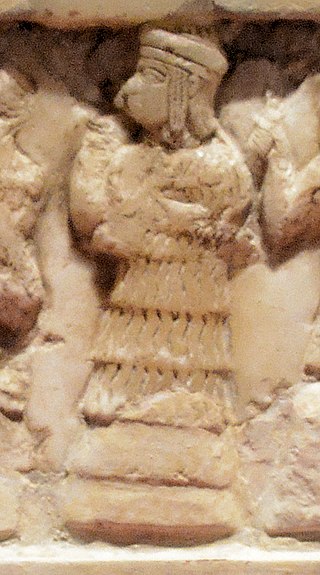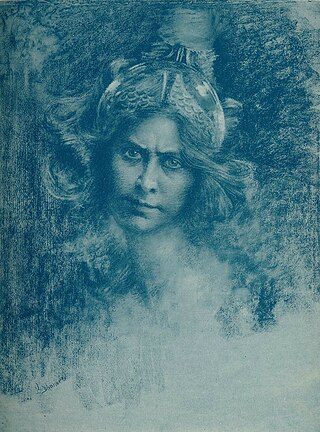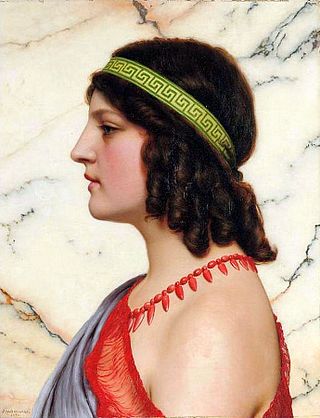
Sappho was an Archaic Greek poet from Eresos or Mytilene on the island of Lesbos. Sappho is known for her lyric poetry, written to be sung while accompanied by music. In ancient times, Sappho was widely regarded as one of the greatest lyric poets and was given names such as the "Tenth Muse" and "The Poetess". Most of Sappho's poetry is now lost, and what is extant has mostly survived in fragmentary form; only the Ode to Aphrodite is certainly complete. As well as lyric poetry, ancient commentators claimed that Sappho wrote elegiac and iambic poetry. Three epigrams formerly attributed to Sappho are extant, but these are actually Hellenistic imitations of Sappho's style.

Inanna is the ancient Mesopotamian goddess of love, war, and fertility. She is also associated with sensuality, procreation, divine law, and political power. Originally worshiped in Sumer, she was known by the Akkadian Empire, Babylonians, and Assyrians as Ishtar. Her primary title was "the Queen of Heaven".
Anna Komnene, commonly Latinized as Anna Comnena, was a Byzantine Greek princess and historian. She is the author of the Alexiad, an account of the reign of her father, Byzantine emperor Alexios I Komnenos. Her work constitutes the most important primary source of Byzantine history of the late 11th and early 12th centuries, as well as of the early Crusades. Although she is best known as the author of the Alexiad, Anna played an important part in the politics of the time and attempted to depose her brother, John II Komnenos, as emperor in favour of her husband, Nikephoros.

Anyte of Tegea was a Hellenistic poet from Tegea in Arcadia. Little is known of her life, but twenty-four epigrams attributed to her are preserved in the Greek Anthology, and one is quoted by Julius Pollux; nineteen of these are generally accepted as authentic. She introduced rural themes to the genre, which became a standard theme in Hellenistic epigrams. She is one of the nine outstanding ancient women poets listed by Antipater of Thessalonica in the Palatine Anthology. Her pastoral poetry may have influenced Theocritus, and her works were adapted by several later poets, including Ovid.
Judy Grahn is an American poet and author.

Enheduanna was the entu (high) priestess of the moon god Nanna (Sīn) in the Sumerian city-state of Ur in the reign of her father, Sargon of Akkad. She was likely appointed by her father as the leader of the religious group at Ur to cement ties between the Akkadian religion of her father and the native Sumerian religion.

Corinna or Korinna was an ancient Greek lyric poet from Tanagra in Boeotia. Although ancient sources portray her as a contemporary of Pindar, not all modern scholars accept the accuracy of this tradition. When she lived has been the subject of much debate since the early twentieth century, proposed dates ranging from the beginning of the fifth century to the late third century BC.

The Alexiad is a medieval historical and biographical text written around the year 1148, by the Byzantine princess Anna Komnene, daughter of Emperor Alexios I Komnenos. It was written in a form of artificial Attic Greek. Anna described the political and military history of the Byzantine Empire during the reign of her father, thus providing a significant account on the Byzantium of the High Middle Ages. Among other topics, the Alexiad documents the Byzantine Empire's interaction with the Crusades and highlights the conflicting perceptions of the East and West in the early 12th century. It does not mention the schism of 1054 – a topic which is very common in contemporary writing. It documents firsthand the decline of Byzantine cultural influence in eastern and western Europe, particularly in the West's increasing involvement in its geographic sphere. The Alexiad was paraphrased in vernacular medieval Greek in mid-14th century to increase its readability, which testifies to the lasting interest in the work.

Telesilla was an ancient Greek lyric poet from Argos, active in the fifth century BC. She is known for her supposed role in the defence of Argos in 494 BC, which is doubted by modern scholars. Only a few fragments of her poetry survive, several of which reference the gods Apollo and Artemis. The longest surviving fragment, only two lines, is quoted by the grammarian Hephaestion to illustrate the Telesillan metre, named after her. She was apparently famous in antiquity, included by Antipater of Thessalonica in his canon of women poets; in the twentieth century she inspired a poem by the imagist poet H.D.

Praxilla, was a Greek lyric poet of the 5th century BC from Sicyon on the Gulf of Corinth. Five quotations and three paraphrases from her poems survive. The surviving fragments of her work come from both religious choral lyric and drinking songs (skolia); the three paraphrases are all versions of myths. Various social contexts have been suggested for Praxilla based on this range of surviving works, including that her poetry was in fact composed by two different authors; that Praxilla was a hetaira (courtesan); that she was a professional musician; or that the drinking songs derive from a non-elite literary tradition rather than being authored by a single writer. Praxilla was apparently well-known in antiquity: she was sculpted in bronze by Lysippus and parodied by Aristophanes.

Erinna was an ancient Greek poet. She is best known for her long poem The Distaff, a 300-line hexameter lament for her childhood friend Baucis, who had died shortly after her marriage. A large fragment of this poem was discovered in 1928 at Oxyrhynchus in Egypt. Along with The Distaff, three epigrams ascribed to Erinna are known, preserved in the Greek Anthology. Biographical details about Erinna's life are uncertain. She is generally thought to have lived in the first half of the fourth century BC, though some ancient traditions have her as a contemporary of Sappho; Telos is generally considered to be her most likely birthplace, but Tenos, Teos, Rhodes, and Lesbos are all also mentioned by ancient sources as her home.

Anna Louisa Karsch was a German autodidact and poet from the Silesia region, known to her contemporaries as "Die Karschin" and "the German Sappho". She became the first German woman to "live from the proceeds of her own literary works."

Dumuzid or Dumuzi or Tammuz, known to the Sumerians as Dumuzid the Shepherd and to the Canaanites as Adon, is an ancient Mesopotamian and Levantine deity associated with agriculture and shepherds, who was also the first and primary consort of the goddess Inanna. In Sumerian mythology, Dumuzid's sister was Geshtinanna, the goddess of agriculture, fertility, and dream interpretation. In the Sumerian King List, Dumuzid is listed as an antediluvian king of the city of Bad-tibira and also an early king of the city of Uruk.
Sappho 31 is an archaic Greek lyric poem by the ancient Greek poet Sappho of the island of Lesbos. The poem is also known as phainetai moi after the opening words of its first line. It is one of Sappho's most famous poems, describing her love for a young woman.

Sappho 16 is a fragment of a poem by the archaic Greek lyric poet Sappho. It is from Book I of the Alexandrian edition of Sappho's poetry, and is known from a second-century papyrus discovered at Oxyrhynchus in Egypt at the beginning of the twentieth century. Sappho 16 is a love poem – the genre for which Sappho was best known – which praises the beauty of the narrator's beloved, Anactoria, and expresses the speaker's desire for her now that she is absent. It makes the case that the most beautiful thing in the world is whatever one desires, using Helen of Troy's elopement with Paris as a mythological exemplum to support this argument. The poem is at least 20 lines long, though it is uncertain whether the poem ends at line 20 or continues for another stanza.
Melinno was a Greek lyric poet. She is known from a single surviving poem, known as the "Ode to Rome". The poem survives in a quotation by the fifth century AD author Stobaeus, who included it in a compilation of poems on manliness. It was apparently included in this collection by mistake, as Stobaeus misinterpreted the word ρώμα in the first line as meaning "strength", rather than being the Greek name for the city of Rome.

The Ode to Aphrodite is a lyric poem by the archaic Greek poet Sappho, who wrote in the late seventh and early sixth centuries BCE, in which the speaker calls on the help of Aphrodite in the pursuit of a beloved. The poem survives in almost complete form, with only two places of uncertainty in the text, preserved through a quotation from Dionysius of Halicarnassus' treatise On Composition and in fragmentary form in a scrap of papyrus discovered at Oxyrhynchus in Egypt.

The Tithonus poem, also known as the old age poem or the New Sappho, is a poem by the archaic Greek poet Sappho. It is part of fragment 58 in Eva-Maria Voigt's edition of Sappho. The poem is from Book IV of the Alexandrian edition of Sappho's poetry. It was first published in 1922, after a fragment of papyrus on which it was partially preserved was discovered at Oxyrhynchus in Egypt; further papyrus fragments published in 2004 almost completed the poem, drawing international media attention. One of very few substantially complete works by Sappho, it deals with the effects of ageing. There is scholarly debate about where the poem ends, as four lines previously thought to have been part of the poem are not found on the 2004 papyrus.

Sappho was an ancient Greek lyric poet from the island of Lesbos. She wrote around 10,000 lines of poetry, only a small fraction of which survives. Only one poem is known to be complete; in some cases as little as a single word survives. Modern editions of Sappho's poetry are the product of centuries of scholarship, first compiling quotations from surviving ancient works, and from the late 19th century rediscovering her works preserved on fragments of ancient papyri and parchment. Along with the poems which can be attributed with confidence to Sappho, a small number of surviving fragments in her Aeolic dialect may be by either her or her contemporary Alcaeus. Modern editions of Sappho also collect ancient "testimonia" which discuss Sappho's life and works.
If Not, Winter: Fragments of Sappho is a book by the Canadian classicist and poet Anne Carson, first published in 2002. It contains a translation of the surviving works of the archaic Greek poet Sappho, with the Greek text on facing pages, based on Eva-Maria Voigt's 1971 critical edition. Carson's translation closely follows the word-order of Sappho's Greek, and marks lacunae in the manuscripts with square brackets. If Not, Winter was widely praised and is considered a significant modern translation of Sappho's work.














